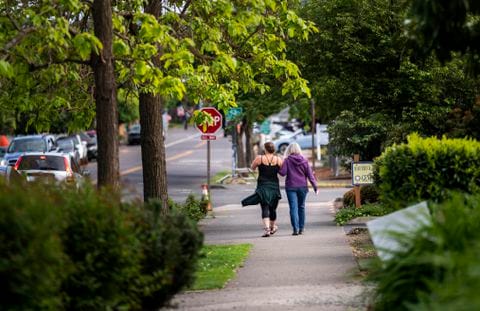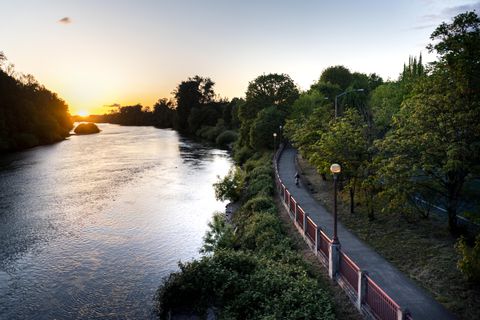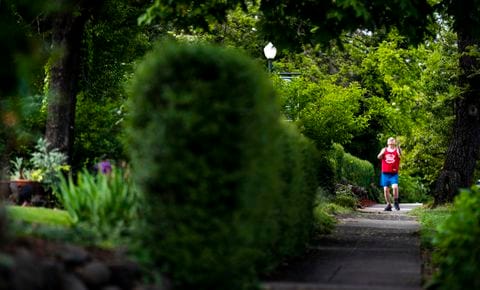See you in 20 (or less): Living where access is within a short walk or bike ride
When Magdalena Reilly was looking for a place where she could live and work without owning a car, she settled on Eugene, Ore., among a small list of options across the country. Four years later, she and her husband haven’t looked back, as they’re able to reach everything they need within a 20-minute walk or a short bike ride.
“In the world that we live in now, where everything is technology-based and people sit in front of screens for work, it’s nice to get away from that,” Reilly said about her bicycle commute. “It’s a way to be outside in nature, with trees everywhere and the smell of mountain air. And it’s great exercise. Since I bike to work it’s almost like I don’t have to work out.”
Eugene, in turn, is one of several cities across the country trying to give more people the chance to live the lifestyle she describes. The city is pushing several initiatives to promote “20-minute living,” the ability to reach important destinations like grocery stores and workplaces within that time frame.
Property tax increases aim to boost affordable housing inventories
City leaders have set a goal of making 90 percent of Eugene 20-minute friendly by 2030. Touted benefits include better air quality, a healthier population, higher property values and lower transportation costs for those who can eschew an automobile (according to AAA, the average price of maintaining a car in the United States is $8,734 per year). It’s an ambitious goal for a city where, like most of the United States, the car remains king.
Reilly, 34, works in e-commerce. She grew up in New York City, where almost every neighborhood boasts a laundromat, supermarket, schools and restaurants within walking distance. Seeking a change of pace and weather, she moved to San Diego in 2010 and drove regularly for the first time. She and her husband eventually grew tired of “car culture” and sought a place where they could get around as pedestrians. After extensive research, they moved to Eugene in 2017 and are hoping it gets even more 20-minute friendly in the years to come.
Making cities more walkable

Families enjoy ice cream in downtown Eugene, which is easy to traverse.

People bike and fish off the DeFazio Bridge in Eugene.

People socialize and enjoy wine from the Willamette Valley in downtown Eugene. (Photos by Melina Mara/The Washington Post)
TOP: Families enjoy ice cream in downtown Eugene, which is easy to traverse. BOTTOM LEFT: People bike and fish off the DeFazio Bridge in Eugene. BOTTOM RIGHT: People socialize and enjoy wine from the Willamette Valley in downtown Eugene. (Photos by Melina Mara/The Washington Post)
Mark Edlen is credited with inventing the term “20-minute living.” Edlen is the CEO of Portland-based Edlen & Co., formerly Gerding Edlen Development, and as such it’s not surprising that Oregon established itself as a leader in the movement.
Edlen chose 20 minutes because that’s about how long it takes to walk across downtown Portland. “We used to joke about ‘killing the car,’ and we’d joke internally about how we were succeeding if people felt comfortable jaywalking,” said Edlen, who founded the company in 1996. If people felt safe jaywalking, the theory went, then cars were not dominating the built environment in a way that’s inhospitable to other forms of transportation. So Edlen and his company set out to create places where people could get around within 20 minutes, be it by walking, bike, public transit or, as a last resort, by car. He eventually took his work to cities as far away as Boston.
“Twenty-five years ago, contractors and engineers weren’t all that interested [in 20-minute living],” Edlen said. “Today everyone is interested. What was pioneering then is now pretty much common practice.”

A family rides bikes through a downtown neighborhood in Eugene.

People wait for a bus at a Eugene station.

People leave a bus station. (Photos by Melina Mara/The Washington Post)
TOP: A family rides bikes through a downtown neighborhood in Eugene. BOTTOM LEFT: People wait for a bus at a Eugene station. BOTTOM RIGHT: People leave a bus station. (Photos by Melina Mara/The Washington Post)
Making cities more walkable involves creating a more compact footprint, where more businesses are built near existing homes. But it also means building housing near existing businesses, such as stores and restaurants.
“Compact development and 20-minute neighborhoods are the twin pillars of growth management for Eugene,” said Terri Harding, the city of Eugene’s principal planner for long-range planning. “We want to promote equitable access to city services in all parts of the city.”
 People walk toward downtown from their Eugene neighborhood just blocks away. (Melina Mara/The Washington Post)
People walk toward downtown from their Eugene neighborhood just blocks away. (Melina Mara/The Washington Post) Many areas are already walkable. Reilly lives in Jefferson Westside, near downtown. But enhancing walkability farther out will be challenging.
“Downtown is our gold star 20-minute neighborhood, it’s our cultural and civic center,” Harding said. “Everything you could need is downtown, and it’s the hub of our transit system. It’s the neighborhood with the most access, and we continue to get residential building applications for downtown.”
Building near bus and transit stops is especially important. Eugene is expanding its bus rapid transit system and developing around it, hoping to increase access across the city.
Human-powered transport
 A cyclist rides on a trail at sunset along the Willamette River in Eugene. (Melina Mara/The Washington Post)
A cyclist rides on a trail at sunset along the Willamette River in Eugene. (Melina Mara/The Washington Post) The 20-minute concept is gaining traction in places far from the coasts as well. Ann Arbor, Mich., has set a goal of having 100 percent of residents live in 20-minute neighborhoods by 2030. For now, the 12 percent of residents who don’t have access to a car are at a big disadvantage — 109,000 jobs can be reached within a 20-minute drive, but only 30,000 jobs are within a 20-minute walk or transit ride. People of color are 37 percent more likely to lack 20-minute access, according to the city’s comprehensive transportation plan.
Accessory dwellings offer one solution to the affordable housing problem
Ann Arbor is building a lot of housing downtown, much of it affordable, and city leaders hope that better walkability will also lead to better outcomes for seniors, who can maintain independence without driving. The idea of emphasizing human-powered transportation and public transit trips that begin and end with walking is a big shift from a few decades ago.
 Eugene stands out for its walkability. (Melina Mara/The Washington Post)
Eugene stands out for its walkability. (Melina Mara/The Washington Post) “Early in my career, in the 1980s, the emphasis was on the completion of the interstate highway system. It was about moving people by moving vehicles,” said Eli Cooper, Ann Arbor’s transportation program manager. “Ann Arbor is on the other edge of the spectrum at this point. As a mature, developed, urban community, our transportation strategies are not about building or widening roads, but about finding safe and effective ways for people to move about our community to meet their needs.”
Car-share and bike-share programs are one aspect of Ann Arbor’s updated transportation plan, as are more low-tech solutions such as filling in sidewalk gaps. Cooper said Ann Arbor is more walking-friendly than most of the United States, yet still has a lot of room for improvement.
“This is a culmination of decades of emphasizing that transportation is a strategy to achieve a community’s values and aspirations,” Cooper said.
While the term “20-minute neighborhood” seems to refer primarily to transportation, it also speaks to land use. Planning and zoning are major factors as well, with more mixed-use and infill development needed to realize the vision.

People walk and play in Eugene’s Hendricks Park.

The Miller and Mendelson families enjoy a picnic, riding bikes, playing near the river and more in Eugene.

Lily Miller, 4, bikes with her friends at Alton Baker Park along the Willamette River. (Photos by Melina Mara/The Washington Post)
TOP: People walk and play in Eugene’s Hendricks Park. BOTTOM LEFT: The Miller and Mendelson families enjoy a picnic, riding bikes, playing near the river and more in Eugene. BOTTOM RIGHT: Lily Miller, 4, bikes with her friends at Alton Baker Park along the Willamette River. (Photos by Melina Mara/The Washington Post)
Ann Arbor has already changed a lot of its zoning to allow for denser housing and homes in previously commercial-only areas.
“I think 20 minutes is a great way of measuring success when it comes to providing opportunities for walking and biking,” said Brett Lenart, Ann Arbor’s planning manager. “It puts a little bit more specificity around what that means.”
The other challenge is in convincing developers to build in a certain location so that it also makes economic sense.
“It’s easy to support and work toward the aspiration of having a grocery store within close proximity, and I think that’s a great goal,” Lenart said.
“But there are also economic factors to it. I don’t have the expertise of operating a grocery store,” he added.
“I think the city and certainly myself have a lot to learn about those dynamics to make sure that we are setting reasonable goals and looking for the right carrots and sticks that can be put together to get there. It won’t all be public policy decisions. Some of it will be market response.”






